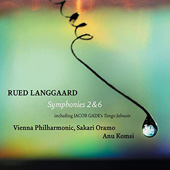

Symphony No. 2 'Vaarbrud' (Awakening of Spring)
Symphony No. 6 'Det Himmelrivende' (The Heaven-Rending)
Upaaagtede Morgenstjerner (Unnoticed Morning Stars)
Jacob Gade: Tango Jalousie 'Tango Tzigane'
Danish composer Rued Langgaard (1893-1952) must have suffered from a combination of delusions of grandeur, deep sadness, high sensibility, disillusionment, and feelings of dejection, all of which may have prophetically brought on his own foundering within his native country. After all, with titles like The Heaven-Rending, The Music of the Spheres, Sun Deluge, Antichrist, etc ... attached to his works, he most likely envisioned much more in his music than what it actually conjured up to the listeners. As well as being ostentatious, melodramatic, and hyper-romantic , his music is if anything, finely crafted, sagacious and complex. In other words problematic for the average listener. It is nonetheless just as remarkable and staggering music as that of Richard Strauss, Gustav Mahler and the like, and when given its due attentiveness, just as stupefying a listening experience.
The opening movement of the Symphony No. 2 'Vaarbrud' (Awakening of Spring) has all the sweep and emotive drive typical of all the expansive tone-poems written at the time, and is distinguished with highly detailed and refined orchestration skills for a twenty year old composer. Every time the main theme reappears it seems re-energized and more opulent, and caps everything at the end with blaring brass and orchestral bravura. Just like its tempo marking Lento religioso quasi adagio suggests, the middle slow movement sounds like a quiet hymn praising nature's reawakening, and is suffused by exquisite writing for the strings throughout. It reminds me of some of Edvard Grieg's bucolic settings, painting life and nature with idyllic brushstrokes. Just like Mahler's Symphony No. 4, the third and final movement is scored for soprano and orchestra. It is based on a poem by Emil Rittershaus which alludes to spring as being the Sunday of the world in a spiritual (religious) sense. As it develops it takes on highly dramatic and operatic overtones, and ends the whole symphony with a brilliant stroke of power and hope. Soprano Anu Komsi does full justice to the text and music's uplifting expanse.
Now the Symphony No. 6 'Det Himmelrivende' (The Heaven-Rending), composed in 1920 and revised ten years later, is a completely different kettle of fish. It's laid out as a single movement divided into seven segments which act as variations on the opening theme, and marked with expressive headings like Corrosif misérable religieux, Frenetico marziale, Mosso furioso, Maestoso frenetico, Magnificamente, Glorificazione, etc ..., and in my opinion, is one of the most astounding examples of clever thematic manipulation, akin to the final movement of Gustav Mahler's Symphony No. 7, but with cataclysmic effects. Main ideas from this symphony were later drawn upon in his opera 'Antichrist'. The opening Thema (version I), belongs very much in the same idyllic state as his second symphony, but with a highly unsettling undertone. Thema (version II), with its clanging bells and heavy brass declamations, represents the Antichrist, or as Langgaard himself described it in 1949, "the spiritual forces of evil in the heavenly places". This is a symphonic work highly charged with religious context. It gradually builds up to battles between good and evil of apocalyptic proportions, pushing all the groups of the orchestra to their maximum limits into a frighteningly grandiose clash of thematic material. It all ends with the return of the beautiful opening theme, which conclusively reigns over evil with a massive pipe organ joining ranks with the full orchestra to bathe the ending of the symphony in glorious light.
But no worries, what follows will surely wipe the blood off your hands. Upaaagtede Morgenstjerner (Unnoticed Morning Stars), which is the second movement from his Symphony No. 14 (1948) and which Langgaard himself pointed out could be performed on its own, is one of the most masterfully crafted slow movements I've heard. It ranks right up there along with Mahler's finest. Scored for strings alone, it plumbs the depths of harmonic potential and resurfaces bearing pearls. Unfortunately, Langgaard never heard it as the symphony was premièred only 27 years after his death.
As pointed out in this review of symphonies by Per Nørgård, another notable Danish composer, the Vienna Philharmonic members do this music full justice, and conductor Sakari Oramo certainly elicits all of its finer details, from tender gestures to demonic outburts, and draws you deeper into Langgaard's visionary and inspired musical journey.
Jean-Yves Duperron - September 2018